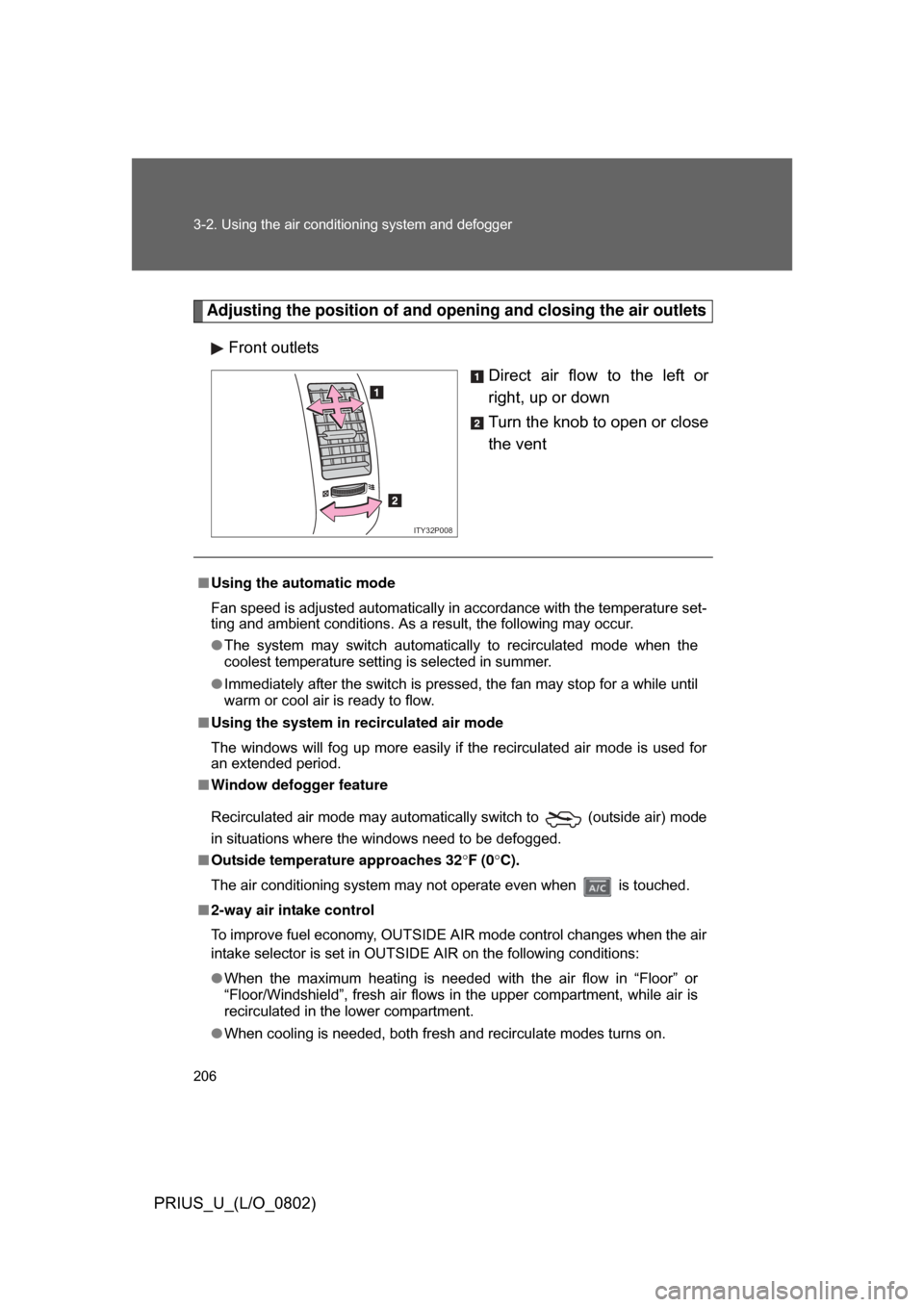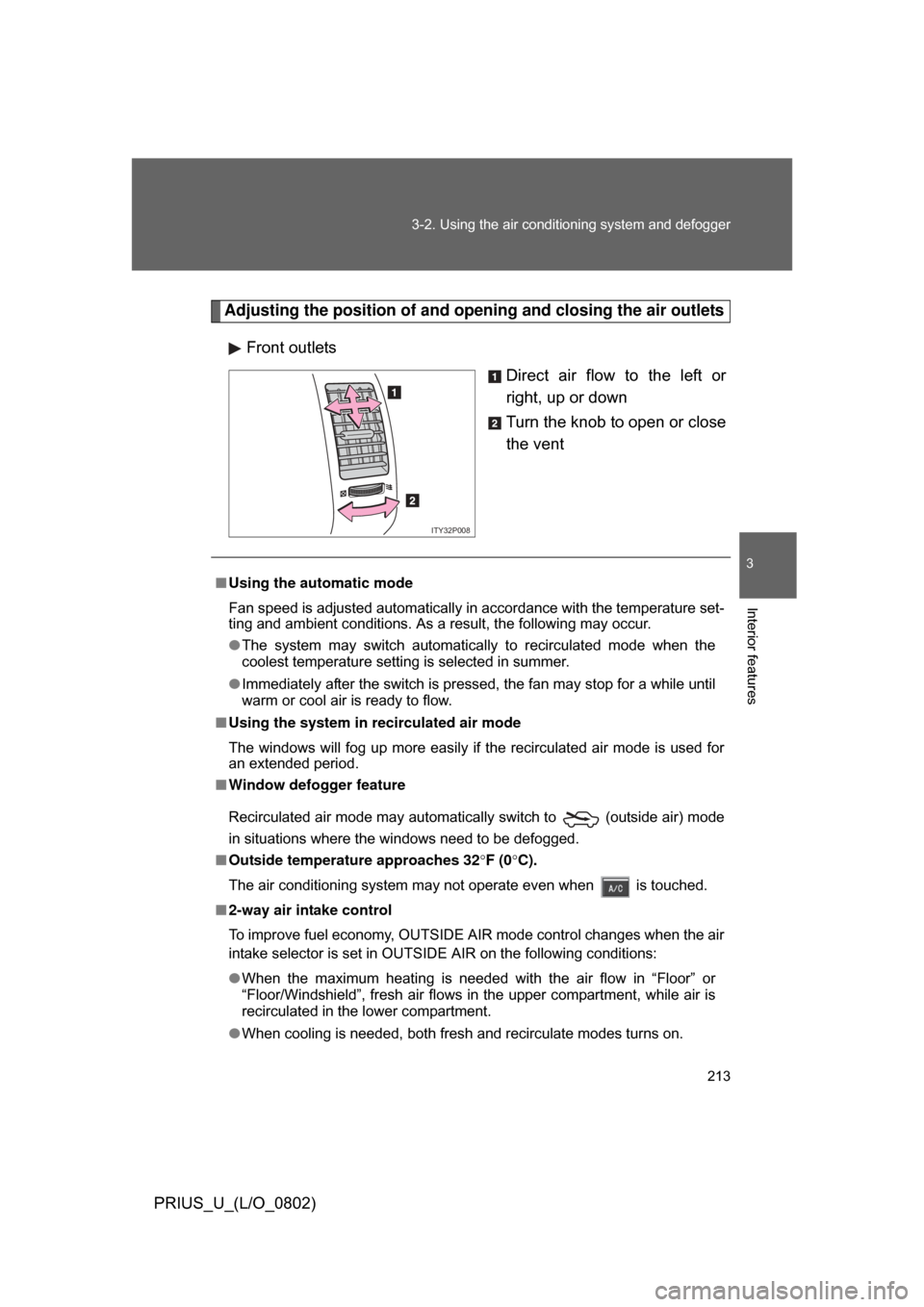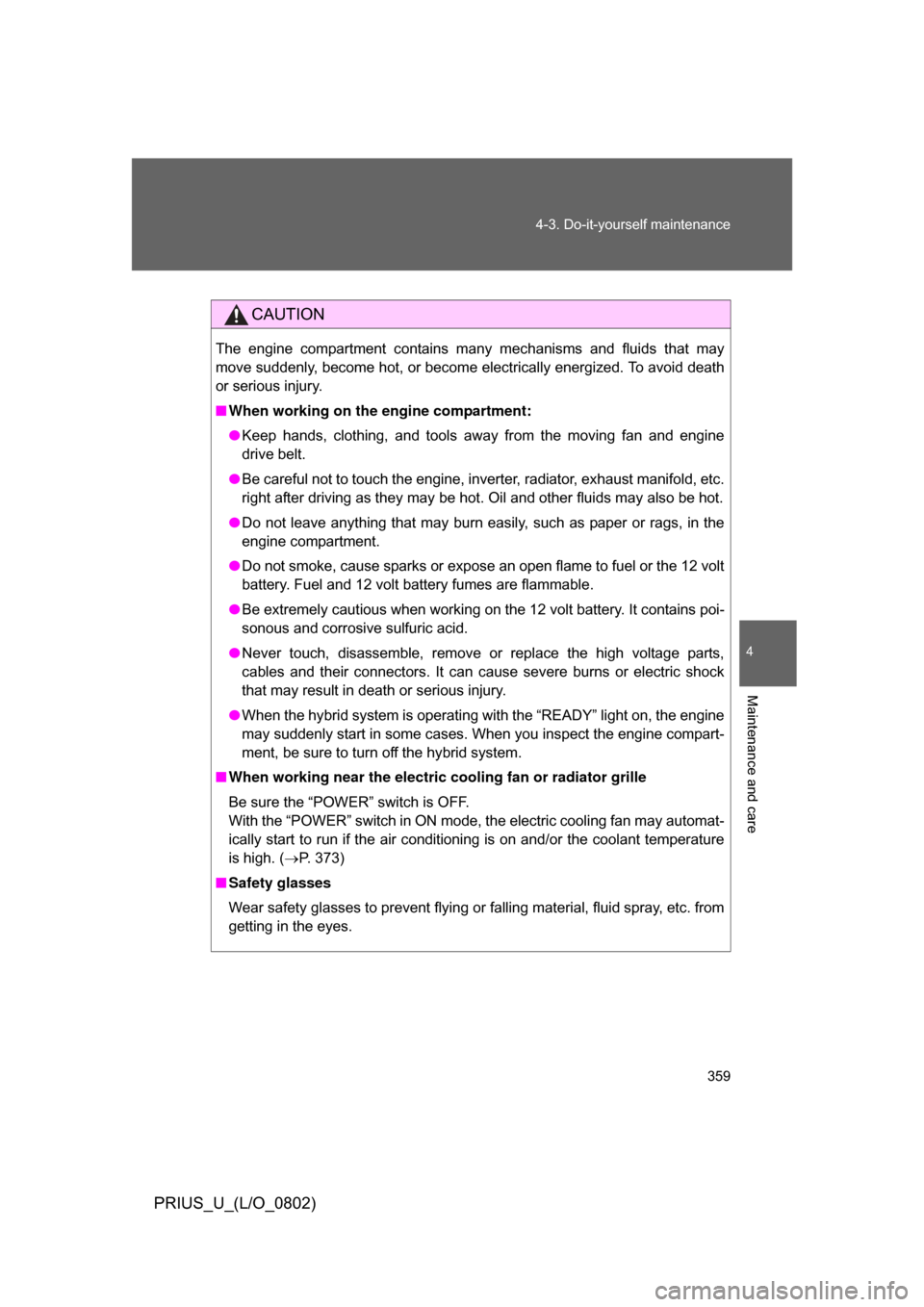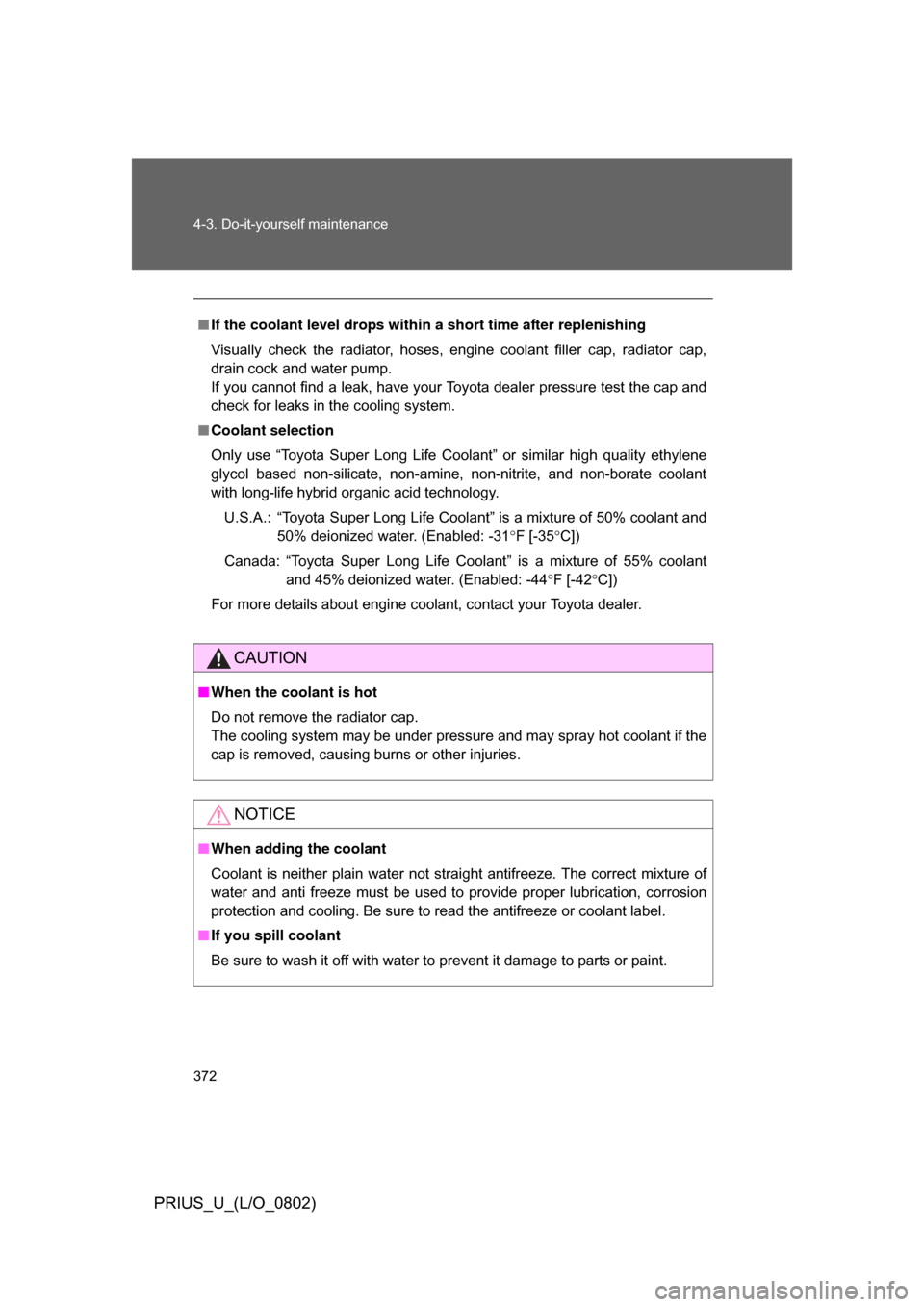Page 25 of 512

25
1-1. Hybrid system
1
Before driving
PRIUS_U_(L/O_0802)
■
Sounds and vibrations specific to a hybrid vehicle
There may be no engine sounds or vibration even though the vehicle is able
to move. Always put the shift lever in “P” when parked.
The following sounds or vibrations may occur when the hybrid system is
operating, and are not a malfunction.
● Motor sounds may be heard from the engine compartment.
● Sounds may be heard from the hybrid battery (traction battery) behind
the rear seat when the hybrid system starts or stops.
● Sounds from the hybrid system may be heard when the back door lid is
open.
● Sounds may be heard from the transmission when the hybrid system
starts or stops.
● Engine sounds may be heard when accelerating sharply.
● Sounds may be heard from the regenerative brake when you press the
brake pedal.
● Vibration may be felt when the gasoline engine starts or stops.
● You may hear cooling fan sounds coming from the air intake vents behind
the rear seat.
■ Maintenance, repair, recycling, and disposal
Contact your Toyota dealer regarding maintenance, repair, recycling and dis-
posal. Do not dispose of the vehicle yourself.
Page 27 of 512
27
1-1. Hybrid system
1
Before driving
PRIUS_U_(L/O_0802)
■
Hybrid battery air vent
Hybrid battery air vent
There is an air intake vent on the
side of the rear right seatback for
the purpose of cooling the hybrid
battery (traction battery). If the
vent becomes blocked, the hybrid
battery may overheat, leading to
a reduction in hybrid battery out-
put.
Emergency shut off system
The emergency shut off system blocks off the high voltage current
and stops the fuel pump to minimize the risk of electrocution and fuel
leakage when a certain level of impact is detected by the impact sen-
sor. If the emergency shut off syste m activates, your vehicle will not
restart. To restart the hybrid system, contact your Toyota dealer.
Energy monitor/consumption screen
You can view the status of your hybrid system on the touch screen
( P. 186). The following images are examples only, and may vary
slightly from actual conditions.
Page 206 of 512

206 3-2. Using the air conditioning system and defogger
PRIUS_U_(L/O_0802)
Adjusting the position of and opening and closing the air outlets
Front outlets Direct air flow to the left or
right, up or down
Turn the knob to open or close
the vent
ITY32P008
■Using the automatic mode
Fan speed is adjusted automatically in accordance with the temperature set-
ting and ambient conditions. As a result, the following may occur.
● The system may switch automatically to recirculated mode when the
coolest temperature setting is selected in summer.
● Immediately after the switch is pressed, the fan may stop for a while until
warm or cool air is ready to flow.
■ Using the system in recirculated air mode
The windows will fog up more easily if the recirculated air mode is used for
an extended period.
■ Window defogger feature
Recirculated air mode may automatically switch to
(outside air) mode
in situations where the windows need to be defogged.
■ Outside temperature approaches 32 F (0 C).
The air conditioning system may not operate even when is touched.
■ 2-way air intake control
To improve fuel economy, OUTSIDE AIR mode control changes when the air
intake selector is set in OUTSIDE AIR on the following conditions:
● When the maximum heating is needed with the air flow in “Floor” or
“Floor/Windshield”, fresh air flows in the upper compartment, while air is
recirculated in the lower compartment.
● When cooling is needed, both fresh and recirculate modes turns on.
Page 213 of 512

213
3-2. Using the air conditioning system
and defogger
3
Interior features
PRIUS_U_(L/O_0802)
Adjusting the position of and opening and closing the air outlets
Front outlets Direct air flow to the left or
right, up or down
Turn the knob to open or close
the vent
ITY32P008
■Using the automatic mode
Fan speed is adjusted automatically in accordance with the temperature set-
ting and ambient conditions. As a result, the following may occur.
● The system may switch automatically to recirculated mode when the
coolest temperature setting is selected in summer.
● Immediately after the switch is pressed, the fan may stop for a while until
warm or cool air is ready to flow.
■ Using the system in recirculated air mode
The windows will fog up more easily if the recirculated air mode is used for
an extended period.
■ Window defogger feature
Recirculated air mode may automatically switch to
(outside air) mode
in situations where the windows need to be defogged.
■ Outside temperatur e approaches 32F (0 C).
The air conditioning system may not operate even when is touched.
■ 2-way air intake control
To improve fuel economy, OUTSIDE AIR mode control changes when the air
intake selector is set in OUTSIDE AIR on the following conditions:
● When the maximum heating is needed with the air flow in “Floor” or
“Floor/Windshield”, fresh air flows in the upper compartment, while air is
recirculated in the lower compartment.
● When cooling is needed, both fresh and recirculate modes turns on.
Page 359 of 512

359
4-3. Do-it-yourself maintenance
4
Maintenance and care
PRIUS_U_(L/O_0802)
CAUTION
The engine compartment contains many mechanisms and fluids that may
move suddenly, become hot, or become electrically energized. To avoid death
or serious injury.
■
When working on the engine compartment:
● Keep hands, clothing, and tools away from the moving fan and engine
drive belt.
● Be careful not to touch the engine, inverter, radiator, exhaust manifold, etc.
right after driving as they may be hot. Oil and other fluids may also be hot.
● Do not leave anything that may burn easily, such as paper or rags, in the
engine compartment.
● Do not smoke, cause sparks or expose an open flame to fuel or the 12 volt
battery. Fuel and 12 volt battery fumes are flammable.
● Be extremely cautious when working on the 12 volt battery. It contains poi-
sonous and corrosive sulfuric acid.
● Never touch, disassemble, remove or replace the high voltage parts,
cables and their connectors. It can cause severe burns or electric shock
that may result in death or serious injury.
● When the hybrid system is operating with the “READY” light on, the engine
may suddenly start in some cases. When you inspect the engine compart-
ment, be sure to turn off the hybrid system.
■ When working near the electric cooling fan or radiator grille
Be sure the “POWER” switch is OFF.
With the “POWER” switch in ON mode, the electric cooling fan may automat-
ically start to run if the air conditioning is on and/or the coolant temperature
is high. ( P. 373)
■ Safety glasses
Wear safety glasses to prevent flying or falling material, fluid spray, etc. from
getting in the eyes.
Page 364 of 512
364
4-3. Do-it-yourself maintenance
PRIUS_U_(L/O_0802)
Engine compar tment
■12 volt battery
P. 375
Washer fluid tank
( P. 378)
Brake fluid reservoir ( P. 373)
Engine oil filler cap ( P. 367)
Engine coolant reservoir ( P. 371)Inverter coolant reservoir
( P. 371)
Fuse box ( P. 398)
Radiator ( P. 373)
Condenser ( P. 373)
Electric cooling fans
Engine oil level dipstick ( P. 365)
Page 372 of 512

372 4-3. Do-it-yourself maintenance
PRIUS_U_(L/O_0802)
■If the coolant level drops within a short time after replenishing
Visually check the radiator, hoses, engine coolant filler cap, radiator cap,
drain cock and water pump.
If you cannot find a leak, have your Toyota dealer pressure test the cap and
check for leaks in the cooling system.
■ Coolant selection
Only use “Toyota Super Long Life Coolant” or similar high quality ethylene
glycol based non-silicate, non-amine, non-nitrite, and non-borate coolant
with long-life hybrid organic acid technology.
U.S.A.: “Toyota Super Long Life Coolant” is a mixture of 50% coolant and 50% deionized water. (Enabled: -31 F [-35 C])
Canada: “Toyota Super Long Life Coolant” is a mixture of 55% coolant and 45% deionized water. (Enabled: -44 F [-42C])
For more details about engine coolant, contact your Toyota dealer.
CAUTION
■ When the coolant is hot
Do not remove the radiator cap.
The cooling system may be under pressure and may spray hot coolant if the
cap is removed, causing burns or other injuries.
NOTICE
■When adding the coolant
Coolant is neither plain water not straight antifreeze. The correct mixture of
water and anti freeze must be used to provide proper lubrication, corrosion
protection and cooling. Be sure to read the antifreeze or coolant label.
■ If you spill coolant
Be sure to wash it off with water to prevent it damage to parts or paint.
Page 373 of 512
373
4-3. Do-it-yourself maintenance
4
Maintenance and care
PRIUS_U_(L/O_0802)
Radiator and condenser
Check the radiator and condenser and clear any foreign objects.
If either of the above parts are extremely dirty or you are not sure of
their condition, have your vehicl e checked by your Toyota dealer.
Brake fluid
■ Checking fluid level
The brake fluid level should be
between the “MAX” and “MIN”
lines on the tank.
Make sure to check the fluid type and prepare the necessary items.
■ Adding fluid
CAUTION
■When the engine is hot
Do not remove the radiator cap. The cooling system may be under pressure
and may spray hot coolant if the cap is removed, causing burns or other inju-
ries.
Fluid typeFMVSS No.116 DOT 3 or SAE J1703 brake fluid
ItemsClean funnel